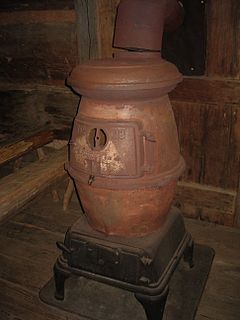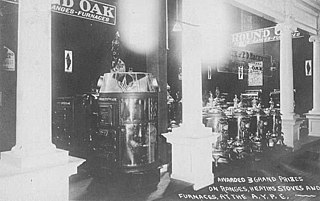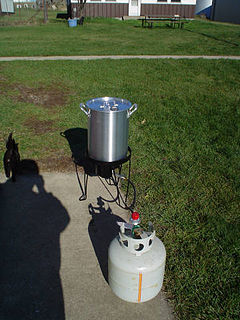 W
WAn agungi is a firebox found in traditional Korean kitchens which is used to burn firewood or other fuel for cooking. It is also a part of the traditional floor heating system, or ondol. The flat cooktop counter or hearth installed over the agungi is called a buttumak (부뚜막).
 W
WA portable stove is a cooking stove specially designed to be portable and lightweight, used in camping, picnicking, backpacking, or other use in remote locations where an easily transportable means of cooking or heating is needed. Portable stoves can be used in diverse situations, such as for outdoor food service and catering and in field hospitals.
 W
WA bachelor griller, mini oven or mini kitchen is a countertop kitchen appliance about the size of a microwave oven but instead can grill, bake, broil or roast food. It generally incorporates one or two heating elements at the top and bottom of the appliance, has one or two hobs on the cooktop, or a ceramic hotplate, and may incorporate a rotisserie.
 W
WBioLite, a startup based in New York City founded in 2006, develops and manufactures off-grid energy products for both the outdoor recreational industry and emerging markets. The company is most well known for their flagship wood-burning stoves that use thermoelectric technology to produce usable electricity from the heat of their fires.
 W
WA clean-burning stove is a stove with reduced toxic emissions. The term commonly refers to wood-burning stoves for domestic heating, although it is also applied to cooking stoves. It is distinct from a clean-burning-fuel stove, which typically burns clean fuels such as ethanol, biogas, LPG, or kerosene. Studies into clean-burning stoves have shown that they reduce the emissions of dangerous particulates and carbon monoxide significantly, use less fuel than regular stoves, and result in fewer burn injuries. However, the emissions they produce are still much greater than the safe limits, and they do not appear to be effective at reducing illnesses such as pneumonia induced by breathing polluted air, which may have many sources.
 W
WImproved cook stoves (ICS) are biomass stoves that are intended to replace traditional cook stoves and open fires, in the context of energy poverty and cooking. As of 2020, more than 2.6 billion people in developing countries lack access to clean, modern fuel and technologies for cooking, and therefore rely on burning polluting fuels such as wood, animal dung, coal, or kerosene for cooking.
 W
WCooker may refer to several types of cooking appliances and devices used for cooking foods.
 W
WThe Dortch Stove Works is an industrial property in Franklin, Tennessee. It also has been known as Allen Manufacturing Company, as Magic Chef Inc., and as Jamison Bedding. Now known as The Factory at Franklin, it is a retail shopping mall with 83 tenants.
 W
WAn electric stove or electric range is a stove with an integrated electrical heating device to cook and bake. Electric stoves became popular as replacements for solid-fuel stoves which required more labor to operate and maintain. Some modern stoves come in a unit with built-in extractor hoods.
 W
WA flattop grill is a cooking appliance that resembles a griddle but performs differently because the heating element is circular rather than straight. This heating technology creates an extremely hot and even cooking surface, as heat spreads in a radial fashion over the surface. Flattop grills have been around for hundreds of years in various forms and evolved in a number of cultures.
 W
WA foot stove consists of a wooden box which is open on one side, with holes or a slab at the top. In it, a bowl made of pottery or metal with burning charcoal was placed. The feet were positioned on top of the stove to become warm. By putting a blanket or clothing on the legs the heat could be isolated and the lower legs were heated.
 W
WA kitchen stove, often called simply a stove or a cooker, is a kitchen appliance designed for the purpose of cooking food. Kitchen stoves rely on the application of direct heat for the cooking process and may also contain an oven, used for baking. "Cookstoves" are heated by burning wood or charcoal; "gas stoves" are heated by gas; and "electric stoves" by electricity. A stove with a built-in cooktop is also called a range.
 W
WA gas stove is a stove that is fuelled by combustible gas such as syngas, natural gas, propane, butane, liquefied petroleum gas or other flammable gas. Before the advent of gas, cooking stoves relied on solid fuels such as coal or wood. The first gas stoves were developed in the 1820s and a gas stove factory was established in England in 1836. This new cooking technology had the advantage of being easily adjustable and could be turned off when not in use. The gas stove, however, did not become a commercial success until the 1880s, by which time supplies of piped gas were available in cities and large towns in Britain. The stoves became widespread on the European Continent and in the United States in the early 20th century.
 W
WA hexamine stove, or hexi-stove, is a cooking stove that uses hexamine fuel tablets. The fuel tablets are also known as hexamethyl-enetetramine or methenamine. The stove's function is use in emergency situations. It acts as a platform for cooking and windbreak for such cooking. The hexamine stove is designed to fold into a compact size for storage.
 W
WThe hibachi is a traditional Japanese heating device. It is a brazier which is either round, cylindrical, or box-shaped, open-topped container, made from or lined with a heatproof material and designed to hold burning charcoal. It is believed hibachi date back to the Heian period. It is filled with incombustible ash, and charcoal sits in the center of the ash. To handle the charcoal, a pair of metal chopsticks called hibashi is used, in a way similar to Western fire irons or tongs. Hibachi were used for heating, not for cooking. It heats by radiation, and is too weak to warm a whole room, often disappointing foreigners who expected such power. Sometimes, people placed a tetsubin over the hibachi to boil water for tea. Later, by the 1900s, some cooking was also done over the hibachi.
 W
WThe Hoàng Cầm stove, named after its inventor, a Viet Minh soldier in 1951, was a stove intake and chimney system which diffused and dissipated smoke from cooking which prevented aerial detection of smoke by American military planes. They were used extensively in the Cu Chi tunnels and other hideouts. Another name for the cooker was the "guitar stove". The system required a deep, covered hole in the ground from which long underground bamboo vents dissipated the smoke.
 W
WA hobo stove is a style of improvised heat-producing and cooking device used in survival situations, by backpackers, hobos, tramps and homeless people. Hobo stoves can be functional to boil water for purification purposes during a power outage and in other survival situations, and can be used for outdoor cooking.
 W
WThe J. L. Mott Iron Works was established by Jordan L. Mott in New York City in the area now called Mott Haven in 1828; the business was continued by his son, J.L. Mott, Jr. The elder Mott specialised in the manufacture of cooking-stoves fueled with anthracite coal. "Stoves and ranges, hot-air furnaces, parlor grates and fenders, fire irons, cauldrons and kettles, statuary, candelabra, fountains garden seats, vases, iron pipes or every kind, water tanks, &c" are mentioned in Benson John Lossing, History of New York City. Mott was interested in the patenting of inventions, but turned down President Buchanan's offer to make him Commissioner of Patents.
 W
WThe Kenya Ceramic Jiko is a portable, charcoal-burning stove used for cooking, found primarily in urban homes in Kenya. It was developed through the collaboration of both local and international groups, to reduce fuel consumption.
 W
WThe lò trấu is a type of versatile fuel burning cook stove used in Vietnam since the 1950s. Lò trấu comes from lò (stove) and trấu. A kitchen with this kind of stove is a bếp trấu, "husk kitchen."
 W
WA multi-fuel stove is similar to a wood-burning stove in appearance and design. Multifuel refers to the capability of the stove to burn wood and also coal, wood pellets, or peat. Stoves that have a grate for the fire to burn on and a removable ash pan are generally considered multi-fuel stoves. If the fire simply burns on a bed of ash, it is a wood-only fuelled appliance, and cannot be used for coal or peat.
 W
WThe Old Weir Stove Company was an historic industrial facility located on West Water Street in Weir Village, Taunton, Massachusetts. The factory consisted of a series of connected brick buildings, located between West Water Street and the west bank of the Taunton River. The factory was built in 1902 and added to the National Register of Historic Places in 1984. It was later occupied by F.B. Rogers Silver Company. In May–June 2009, the site was demolished, except for the northernmost building of the complex.
 W
WThe outdoor wood boiler is a variant of the classic wood stove adapted for set-up outdoors while still transferring the heat to interior buildings.
 W
WA portable stove is a cooking stove specially designed to be portable and lightweight, used in camping, picnicking, backpacking, or other use in remote locations where an easily transportable means of cooking or heating is needed. Portable stoves can be used in diverse situations, such as for outdoor food service and catering and in field hospitals.
 W
WA potbelly stove is a cast-iron, coal-burning or wood-burning stove that is cylindrical with a bulge in the middle. The name is derived from the resemblance of the stove to a fat man's pot belly. Potbelly stoves were used to heat large rooms and were often found in train stations or one-room schoolhouses. The flat top of the stove allows for cooking food or heating water.
 W
WThe Primus stove was the first pressurized-burner kerosene (paraffin) stove, developed in 1892 by Frans Wilhelm Lindqvist, a factory mechanic in Stockholm. The stove was based on the design of the hand-held blowtorch; Lindqvist’s patent covered the burner, which was turned upward on the stove instead of outward as on the blowtorch. The same year, Lindqvist partnered with Johan Viktor Svenson and established J.V. Svenson’s Kerosene Stove Factory for manufacturing the new stoves which were sold under the name Primus. The first model was the No.1 stove, which was quickly followed by a number of similarly-designed stoves of different models and sizes. Shortly thereafter, B.A. Hjorth & Co., a tool and engineering firm begun in Stockholm in 1889, acquired the exclusive rights to sell the Primus stove.
 W
WThe Red Cross stove is a kitchen or parlor stove used for cooking and heating mainly North American homes of the late 19th and early 20th century. The reason for the name "Red Cross" was because of the advertising logo, which featured a red Gothic cross.
 W
WA rocket stove is an efficient and hot burning stove using small-diameter wood fuel. Fuel is burned in a simple combustion chamber containing an insulated vertical chimney, which ensures almost complete combustion prior to the flames reaching the cooking surface. Rocket stove designs are most often used for portable stoves for cooking but the design is also used for large fixed stoves in institutions, and to make rocket mass heaters for heating.
 W
WThe Round Oak Stove Company was founded in Dowagiac, Michigan in 1871 by Philo D. Beckwith. Beckwith cast his first stove around 1867 to heat his struggling foundry and shortly after, the Michigan Central Railroad ordered the heaters for its depots between Detroit and Chicago. By 1871, Beckwith was mainly producing heating stoves, and thus founded the company.
 W
WA Russian stove [Ukrainian: піч] is a unique type of masonry stove that first appeared in the 15th century. It is used both for cooking and domestic heating in traditional Russian, Ukrainian and Belarusian households. The Kyivan stove burns firewood or wood manufacturing waste.
 W
WA Sigri is a stove used for cooking, especially in North India. The fuel used is usually coal, dried cow dung and wood, therefore it is principally used by those who cannot afford liquefied petroleum gas stoves. Sigris are also used during winters for warmth.
 W
WA solar cooker is a device which uses the energy of direct sunlight to heat, cook or pasteurize drink and other food materials. Many solar cookers currently in use are relatively inexpensive, low-tech devices, although some are as powerful or as expensive as traditional stoves, and advanced, large-scale solar cookers can cook for hundreds of people. Because they use no fuel and cost nothing to operate, many nonprofit organizations are promoting their use worldwide in order to help reduce fuel costs and air pollution, and to help slow down deforestation and desertification.
 W
WSouthern Stove Works is a historic factory complex located in the Three Corners District of Richmond, Virginia. The complex includes four contributing red brick buildings built between 1902 and 1920. The buildings housed the foundry, assembly operations, warehouse storage, and metal storage. In 1920, Southern Stove Works vacated the buildings and moved to their new facility, Southern Stove Works, Manchester. By 1921, these buildings were occupied by the J. P. Taylor Leaf Tobacco Company.
 W
WSouthern Stove Works, Manchester is a historic factory complex located in Richmond, Virginia that replaced the company's original factory. The complex includes two contributing prefabricated steel frame buildings built in 1920. The west building contains the original two-story office building that has been connected by one-story infill to the long one-story warehouse building that contained the pressing and mounting departments and a three-part warehouse. The office is a five-by-three-bay, two-story, building measuring 40 by 80 feet and brick curtain walls. The east building today consists of the foundry with attached original washrooms and office, charging room, and an expanded mill room.
 W
WA stove is a device that burns fuel or uses electricity to generate heat inside or on top of the apparatus. It has seen many developments over time and serves the main purpose of cooking food.
 W
WThis is a list of stoves. A stove is an enclosed space in which fuel is burned to provide heating, either to heat the space in which the stove is situated, or to heat the stove itself and items placed on it. Stoves are generally used for cooking and heating purposes.
 W
WA Finn candle is a source of heat and light from a vertically set tree trunk, incised and burning in the middle. It became known in Europe during the 1600s and is now used by forest workers, and for leisure activities. Due to its flat surface and good embers, it can also be used for cooking. Compared to a campfire, it is more compact, and therefore several small heat sources can be distributed over an area.
 W
WA tea stove is a specialized type of Chinese brazier or stove designed to boil water.
 W
WA turkey fryer is an apparatus for deep-frying a turkey. Fried turkey has been a popular item in the Southern United States, and has recently become popular in other parts of the country because of the reduced time needed to cook a turkey in a deep fryer, versus other conventional methods such as an oven or a rotisserie grill.
 W
WA wood-burning stove is a heating appliance capable of burning wood fuel and wood-derived biomass fuel, such as sawdust bricks. Generally the appliance consists of a solid metal closed firebox, often lined by fire brick, and one or more air controls. The first wood-burning stove was patented in Strasbourg in 1557, two centuries before the Industrial Revolution, which would make iron an inexpensive and common material, so such stoves were high end consumer items and only gradually spread in use.
 W
WWoods–Evertz Stove Company Historic District, also known as General Wesco Stove Company, is a historic industrial complex and national historic district located at Springfield, Greene County, Missouri. The district encompasses six contributing buildings associated with a large cast iron stove manufacturer. The district developed between about 1904 and 1953, and all six buildings are in a simple industrial, factory style, with minimal architectural embellishment and have flat, low-pitch and gabled roofs.
 W
WThe World's Largest Stove was an oversized replica of a kitchen stove that was made for the 1893 Chicago World's Fair as a representation of Michigan Stove Company and its products. After the fair finished, the replica was displayed and used for advertising for decades at the company's headquarters in downtown Detroit. The wooden stove replica eventually deteriorated to a poor state and in 1974 the pieces were stored in a warehouse. In the late 1990s, the replica was restored and given a permanent home at Michigan State Fairgrounds. In 2011 it was destroyed by fire, likely caused by a lightning strike.